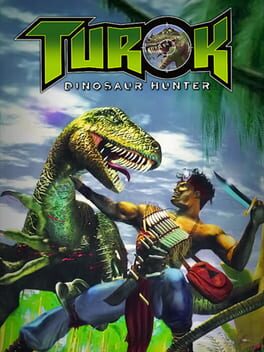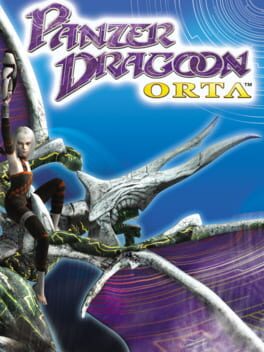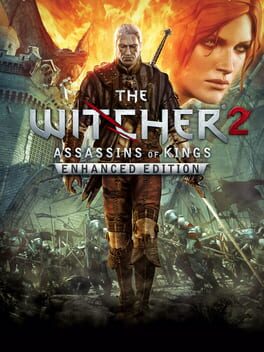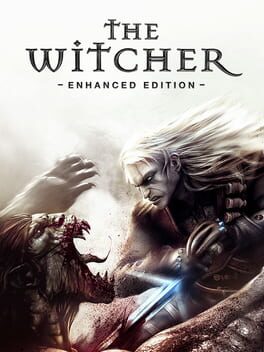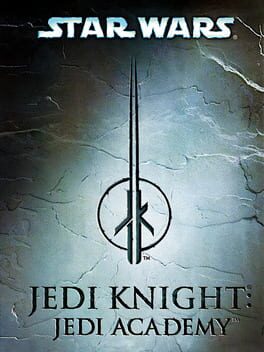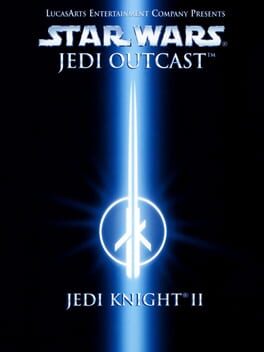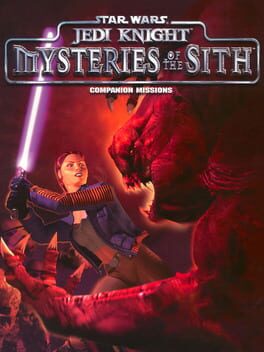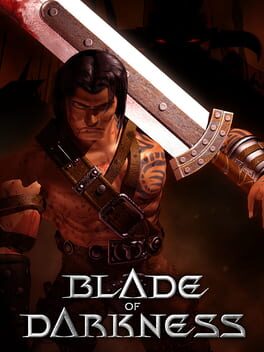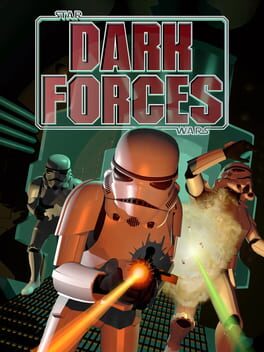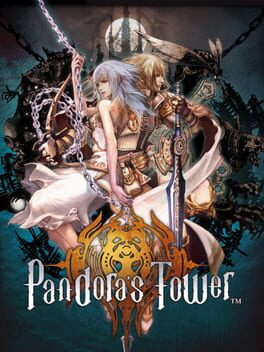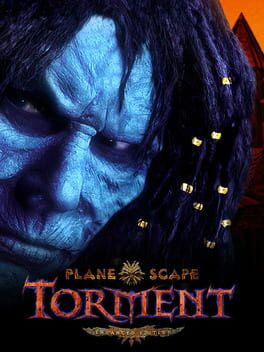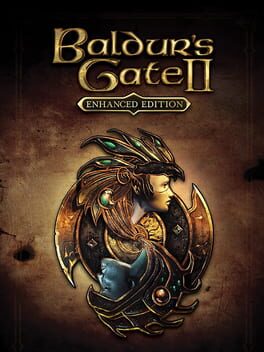All_Regrets
This may be my favorite 90s FPS. Gameplay is a mix of fast-paced shooting and some simple platforming, which isn't as bad as it sounds. Likewise, the collectathon elements of the game to progress were not that painful, and I was able to find all the collectible keys and weapon parts naturally. My biggest gripe with this game, and all of the old-school FPS games is that levels can feel endless and exhausting to go all the way through. The story is mostly non-existent and follows a very comic-book lost lands style story about going through various jungles, canyons, and alien ships in order to defeat evil aliens and some dinosaurs. Despite being called Turok: Dinosaur hunter, the dinosaurs are not all that important and are mostly just mid-level enemies.
2002
Panzer Dragoon Orta was my introduction to the Panzer Dragoon series. It was a tough-as-nails experience that left me exhausted, but satisfied, after each level. Aiming and avoiding attacks demands some serious hyper-focus and quite a few deaths, but it always feels fair. The game's presentation is genuinely amazing. The art and designs are reminiscent of old science-fiction and fantasy art (the Moebius inspiration is clear, he even did the Japanese cover of the original Panzer Dragoon game). Story is also a strong point, following the journey of Orta as she travels across the land to escape and ultimately defeat an empire. Narrative and lore are expanded upon in an extras menu, and it is very impressive how much worldbuilding was done.
I greatly enjoyed my time with Panzer Dragoon Orta, with its gorgeous alien landscapes and made-up language dialogue. It made my imagination run wild in a way that is rare among media.
I greatly enjoyed my time with Panzer Dragoon Orta, with its gorgeous alien landscapes and made-up language dialogue. It made my imagination run wild in a way that is rare among media.
This is my first Castlevania game, so I don't know how it stacks up to the rest of the series, but this is a fantastic game. The most noticeable factors are of course the amazing character art and backgrounds, and the incredible music. It is an absolute pleasure to explore the world, fight enemies, and meet characters. Castlevania's unique victorian-gothic style is rare among games, and really does justice to the vampire/monster-movie tone. Story-wise there is enough of a hook surrounding Shanoa's memories to keep the player invested, even across the several years I took to beat the game on and off.
Gameplay is deeply engaging, from the sheer variety of options and playstyles presented by the glyphs/weapons, to the lengthy dungeons, and the nail-biting boss fights. This is a difficult game, and the only way to get better is the patience to learn how to dodge attacks and/or cheese the bosses via overpowered glyph combos. I personally needed to take breaks and even lookup tips in order to defeat some bosses, but the rewarding feeling of defeating a boss still trumps the frustration.
If you have a way to play this DS game (I used a 3DS), I can absolutely recommend this.
Gameplay is deeply engaging, from the sheer variety of options and playstyles presented by the glyphs/weapons, to the lengthy dungeons, and the nail-biting boss fights. This is a difficult game, and the only way to get better is the patience to learn how to dodge attacks and/or cheese the bosses via overpowered glyph combos. I personally needed to take breaks and even lookup tips in order to defeat some bosses, but the rewarding feeling of defeating a boss still trumps the frustration.
If you have a way to play this DS game (I used a 3DS), I can absolutely recommend this.
The Witcher 2 is a strong sequel to the original game, but I feel it has higher highs and lower lows. In terms of general presentation it is a huge leap forward and is very comparable to first party RPGs of the early 2010s. NPCs look much better and there is a very solid voice cast. Like the first game the writing is the strongest point, with compelling characters and, in my opinion, an even stronger narrative hook. Quests can be adventure-game like, requiring the player to investigate people/areas without always using a big glowing "go here, do this" marker.
One of the main downsides I see with this game is that it feels made for console, rather than for PC. The introduction of some radial UI and the constant use of doors to hide loading, making areas claustrophobic. Maps are, for better and worse, more intricate, mostly being a series of many corridors. Traversal feels like even more of a slog, you will have Geralt rollin' rollin' rollin' rollin' (what) everywhere.
Gameplay is a mixed-bag. The first game was fairly mindless, with simple rhythm-based combat. This game introduces, essentially, Dark Souls-style dodge roll combat (this did come out before the Souls games blew up, so I have no idea if that was actually an influence). Giving the player more control over Geralt does make it a much more engaging experience, but there are some fundamental flaws. One being that the dodge does not have I-frames, so you will get hit when rolling and must essentially use it to only create distance. The combat also bears some similarity to the Batman Arkham games freeflow style, in that Geralt selects attack animations randomly. So there are no combos or deliberate moves. These factors in combination with the Quen spell for blocking one enemy hit means the most straightforward method of fighting is spamming attack and dodging backwards to reapply Quen. Rinse and repeat. So now combat requires more of the player's attention, but still cannot support player expression or in-depth mastery.
That seemed like a lot of complaints, and they were, but as I stated in the beginning, the writing and narrative are very strong to make the tedium of combat worth it. If you enjoyed the first game then this one is a must play.
One of the main downsides I see with this game is that it feels made for console, rather than for PC. The introduction of some radial UI and the constant use of doors to hide loading, making areas claustrophobic. Maps are, for better and worse, more intricate, mostly being a series of many corridors. Traversal feels like even more of a slog, you will have Geralt rollin' rollin' rollin' rollin' (what) everywhere.
Gameplay is a mixed-bag. The first game was fairly mindless, with simple rhythm-based combat. This game introduces, essentially, Dark Souls-style dodge roll combat (this did come out before the Souls games blew up, so I have no idea if that was actually an influence). Giving the player more control over Geralt does make it a much more engaging experience, but there are some fundamental flaws. One being that the dodge does not have I-frames, so you will get hit when rolling and must essentially use it to only create distance. The combat also bears some similarity to the Batman Arkham games freeflow style, in that Geralt selects attack animations randomly. So there are no combos or deliberate moves. These factors in combination with the Quen spell for blocking one enemy hit means the most straightforward method of fighting is spamming attack and dodging backwards to reapply Quen. Rinse and repeat. So now combat requires more of the player's attention, but still cannot support player expression or in-depth mastery.
That seemed like a lot of complaints, and they were, but as I stated in the beginning, the writing and narrative are very strong to make the tedium of combat worth it. If you enjoyed the first game then this one is a must play.
The Witcher 1 is a relatively modern RPG that, like Dragon Age: Origins, also shares many qualities with the CRPGs of the late 90s and early 2000s, particularly in its writing. The story, characters, and world are the real stars of the game and carry it quite heavily. Although the writing has a pretty large variance in quality, with some dialogue feeling out of place, with characters speaking like people the modern period at times (references to psychoanalysis and therapy in a clearly medieval world?), and some pretty terrible and stilted voices for npcs, although I hear the original version of the game had even worse voice acting. That being said most of the main quests and more elaborate side quests are interesting with believable characters and motivations. The detective/mystery quest in Vizima being the part that actually drew me in and convinced me to finish the game. Starting the game, outside of the main city, is pretty dull and is what caused me to drop the game years ago. Once inside the city, the game improves dramatically. Other than the starting areas, the only part of the game I greatly disliked was Chapter IV, where the game breaks its pacing with what feels like a filler arc. It interrupts the flow of the main quest to dump you into a new area that had little to no significance to the main plot threads (and also has an obscene amount of backtracking across big zones).
It has been said a million times before, but the combat in the Witcher is not very good. While functional and not broken, it is mindless, essentially being a rhythm game where you click at appropriate times and Geralt will do long animations of attacks. There is no impact or real feedback, and it quickly becomes an unconscious ritual where you tune out mentally for the majority of your time with the game. As long as you level up enough, you should not have trouble 99% of the time, because there is a lack of gear. You will be using your default equipment for most of the game, only getting a handful of new weapons or a better piece of armor via a couple quests in the latter half of the game. So money becomes kind of useless, only being useful for gambling, a few bribes, and paying the cheap toll to rest at inns. Alchemy was strangely not as important as the game implied it to be. Perhaps it was because I played on the medium/default difficulty, but I only found myself using the night vision and health potions. I used oils a handful of times and never touched the bombs. By doing the majority of the content in an area I was almost always overlevelled for combat encounters.
Admittedly I had been quite biased against the Witcher for years. When the Witcher 3 blew up in 2015, I saw it as a "reddit/HBO" game and wrote the series off. Now that I have beaten the first game I can say that it is quite a good and well-written RPG, I don't consider it to be flawless or even one of my favorites, but I think it is one of the stronger role-playing games of the 2000s era.
It has been said a million times before, but the combat in the Witcher is not very good. While functional and not broken, it is mindless, essentially being a rhythm game where you click at appropriate times and Geralt will do long animations of attacks. There is no impact or real feedback, and it quickly becomes an unconscious ritual where you tune out mentally for the majority of your time with the game. As long as you level up enough, you should not have trouble 99% of the time, because there is a lack of gear. You will be using your default equipment for most of the game, only getting a handful of new weapons or a better piece of armor via a couple quests in the latter half of the game. So money becomes kind of useless, only being useful for gambling, a few bribes, and paying the cheap toll to rest at inns. Alchemy was strangely not as important as the game implied it to be. Perhaps it was because I played on the medium/default difficulty, but I only found myself using the night vision and health potions. I used oils a handful of times and never touched the bombs. By doing the majority of the content in an area I was almost always overlevelled for combat encounters.
Admittedly I had been quite biased against the Witcher for years. When the Witcher 3 blew up in 2015, I saw it as a "reddit/HBO" game and wrote the series off. Now that I have beaten the first game I can say that it is quite a good and well-written RPG, I don't consider it to be flawless or even one of my favorites, but I think it is one of the stronger role-playing games of the 2000s era.
I have finally reached the end of the Dark Forces/Jedi Knight series. This is tied with Dark Forces II as my favorite of the series.
The story of Jedi Academy is very simple, but provides the player with the opportunity to create their own Jedi OC. The options are fairly limited, but there is some variety in species and clothing, which is unexpected for a game of this type. Of course you get to create your own lightsaber as well. The game does away with the following Kyle Katarn from level to level in favor of giving the player the role of a Jedi student. The overall plot is actually quite fun involving a Sith/Dark Jedi cult attempting to revive a Sith to take over the galaxy. It can be very cheesy, but that only adds to the space adventure romp.
Gameplay has been changed quite dramatically. For the moment to moment gameplay, things feel much more refined than in Jedi Outcast: aiming is less wonky and hit detection feels better. Now you start with a lightsaber, so there are really only a handful of moments in which you will pull out a blaster or explosives. The saber combat has been expanded, with more moves and different saber types. I can confidently say that I understand why this game's lightsaber combat is so revered, and with the lightsaber enemies becoming extremely common (multiple per level), you get ample opportunity to get into intense duels. That being said, where Jedi Outcast ended up being quite challenging even on the Jedi/Normal difficulty, Jedi Outcast seems to have had its difficulty reduced. I found myself very rarely dying or even being worried about my health, whereas previous games had me constantly on edge or even stuck at points.
The structure is quite interesting, gone are the long sequential levels of the previous four games. Instead you are given batches of missions that can be completed in any order, each being 10-15 minutes in length on average. From the galaxy map you get to pick a location and get a small text description and briefing from other characters. Mission objectives have great variety from a short item collection mission, to deactivating bombs, to a prison escape. All of this reinforces the idea of being a Jedi asked to solve the problems of local governments and the New Republic. The shortening of the missions also means that there are more or less no puzzles and no down-time, you are always moving forward. This can also contribute to the game feeling a bit easy and even mindless at times. In some ways I liked not getting stuck looking for a tiny hole to progress through, but in other ways it lead to a bit of monotony.
If you have to play one Dark Forces/Jedi Knight game, I would probably recommend this one. The saber combat has not been matched by any other star wars game to date.
The story of Jedi Academy is very simple, but provides the player with the opportunity to create their own Jedi OC. The options are fairly limited, but there is some variety in species and clothing, which is unexpected for a game of this type. Of course you get to create your own lightsaber as well. The game does away with the following Kyle Katarn from level to level in favor of giving the player the role of a Jedi student. The overall plot is actually quite fun involving a Sith/Dark Jedi cult attempting to revive a Sith to take over the galaxy. It can be very cheesy, but that only adds to the space adventure romp.
Gameplay has been changed quite dramatically. For the moment to moment gameplay, things feel much more refined than in Jedi Outcast: aiming is less wonky and hit detection feels better. Now you start with a lightsaber, so there are really only a handful of moments in which you will pull out a blaster or explosives. The saber combat has been expanded, with more moves and different saber types. I can confidently say that I understand why this game's lightsaber combat is so revered, and with the lightsaber enemies becoming extremely common (multiple per level), you get ample opportunity to get into intense duels. That being said, where Jedi Outcast ended up being quite challenging even on the Jedi/Normal difficulty, Jedi Outcast seems to have had its difficulty reduced. I found myself very rarely dying or even being worried about my health, whereas previous games had me constantly on edge or even stuck at points.
The structure is quite interesting, gone are the long sequential levels of the previous four games. Instead you are given batches of missions that can be completed in any order, each being 10-15 minutes in length on average. From the galaxy map you get to pick a location and get a small text description and briefing from other characters. Mission objectives have great variety from a short item collection mission, to deactivating bombs, to a prison escape. All of this reinforces the idea of being a Jedi asked to solve the problems of local governments and the New Republic. The shortening of the missions also means that there are more or less no puzzles and no down-time, you are always moving forward. This can also contribute to the game feeling a bit easy and even mindless at times. In some ways I liked not getting stuck looking for a tiny hole to progress through, but in other ways it lead to a bit of monotony.
If you have to play one Dark Forces/Jedi Knight game, I would probably recommend this one. The saber combat has not been matched by any other star wars game to date.
Jedi Outcast is a huge leap forward for the Dark Forces/Jedi Knight series, as it is the game that introduces the iconic lightsaber combat system. It also continues the story of Kyle Katarn and further explores the post-ROTJ era. It is great to see the new Jedi Academy (no pun intended).
The game almost feels like it is intended to be another entry point to the series, because at the start Kyle has given up his lightsaber and force powers. The player starts with just blasters and will likely not use the third person camera until around halfway through the game.
Combat is very strange, it feels like shots are programmed to miss half the time. I would use the full-auto on the E-11 point-blank on stormtroopers and only like 1/4 of the shots would hit, in spite of my crosshair being red the whole time and the gun essentially in the enemy's face. It leads to a lot of frustrating encounters where you swear you're dead on target and doing no damage. The combat does improve dramatically once a lightsaber and improved force powers are acquired, but the lightsaber has its own set of frustrations. The range of the lightsaber is shorter than it appears, oftentimes you will need to be touching an enemy to actually hit them, and even then you will watch your lightsaber go through someone only for no damage to occur. I'm not sure if it is due to hitboxes or hit detection or range, etc. That being said, when saber combat is firing on all cylinders against other lightsaber users, it is thrilling.
Puzzles can remain a bit cryptic and frustrating, particularly the navigational challenges where a hidden grate or ledge is the path forward, or you need to destroy a piece of scenery with no indication that it is even destructible. I needed to use a guide at times to progress.
In terms of story, it feels like a EU side story, with cameos from some movie characters and locations most fans will know of. I would have liked more variety in terms of enemies, the Imperial Remnant only have 3-4 varieties of stormtrooper and officers. There are a handful of alien thugs as well, but that's it. Thankfully lightsaber enemies shake things up quite a bit. Locations also feel a bit samey toward the end, you spend a lot of time in various grey Imperial ships and installations, it can feel monotonous.
Overall I would put either this game or Jedi Knight I as my favorite so far. I enjoyed the story of Jedi Knight I more, but the lightsaber combat in this game is so strong it is difficult to decide.
The game almost feels like it is intended to be another entry point to the series, because at the start Kyle has given up his lightsaber and force powers. The player starts with just blasters and will likely not use the third person camera until around halfway through the game.
Combat is very strange, it feels like shots are programmed to miss half the time. I would use the full-auto on the E-11 point-blank on stormtroopers and only like 1/4 of the shots would hit, in spite of my crosshair being red the whole time and the gun essentially in the enemy's face. It leads to a lot of frustrating encounters where you swear you're dead on target and doing no damage. The combat does improve dramatically once a lightsaber and improved force powers are acquired, but the lightsaber has its own set of frustrations. The range of the lightsaber is shorter than it appears, oftentimes you will need to be touching an enemy to actually hit them, and even then you will watch your lightsaber go through someone only for no damage to occur. I'm not sure if it is due to hitboxes or hit detection or range, etc. That being said, when saber combat is firing on all cylinders against other lightsaber users, it is thrilling.
Puzzles can remain a bit cryptic and frustrating, particularly the navigational challenges where a hidden grate or ledge is the path forward, or you need to destroy a piece of scenery with no indication that it is even destructible. I needed to use a guide at times to progress.
In terms of story, it feels like a EU side story, with cameos from some movie characters and locations most fans will know of. I would have liked more variety in terms of enemies, the Imperial Remnant only have 3-4 varieties of stormtrooper and officers. There are a handful of alien thugs as well, but that's it. Thankfully lightsaber enemies shake things up quite a bit. Locations also feel a bit samey toward the end, you spend a lot of time in various grey Imperial ships and installations, it can feel monotonous.
Overall I would put either this game or Jedi Knight I as my favorite so far. I enjoyed the story of Jedi Knight I more, but the lightsaber combat in this game is so strong it is difficult to decide.
Mysteries of the Sith is tedious to say the least. The game is much more obtuse than Dark Forces and Jedi Knight I ever were, I spent a lot of time wandering around looking for progression that turned out to be a random hole in the ceiling or a grate obscured under a platform. I really would not have beaten the game if not for two things: walkthroughs and cheats.
The game is quite a bit more difficult than the previous one, leaving the player fighting for every scrap of health and shields they can find, spending most of the time with low health and no shields. The beginning and end of the games are the worst parts in my opinion, with the middle levels being quite fun.
Story-wise there is not much to say, most of the story is just random Mara Jade adventures, which is pretty fun. This is the only game that stars Mara, and so it is great to see her personality. Kyle Katarn takes a back seat, only appearing at the beginning and end of the game. It does feel a bit irrelevant to the overall Dark Forces/Jedi Knight story, and you can really tell it is more of an expansion than a full-fledged sequel.
I don't know if I'd recommend playing it. I did not enjoy my time overall, I would say to just watch a compilation of the cutscenes and move on to Jedi Outcast if you are playing through the whole series like I am.
The game is quite a bit more difficult than the previous one, leaving the player fighting for every scrap of health and shields they can find, spending most of the time with low health and no shields. The beginning and end of the games are the worst parts in my opinion, with the middle levels being quite fun.
Story-wise there is not much to say, most of the story is just random Mara Jade adventures, which is pretty fun. This is the only game that stars Mara, and so it is great to see her personality. Kyle Katarn takes a back seat, only appearing at the beginning and end of the game. It does feel a bit irrelevant to the overall Dark Forces/Jedi Knight story, and you can really tell it is more of an expansion than a full-fledged sequel.
I don't know if I'd recommend playing it. I did not enjoy my time overall, I would say to just watch a compilation of the cutscenes and move on to Jedi Outcast if you are playing through the whole series like I am.
Jedi Knight - Dark Forces II is a very good sequel to the original Dark Forces game. I started the game years ago and got pretty far, but took a long break and forgot most of it. I ended up restarting and using the fan-made remaster mod that adds new graphics.
This game (and the rest of the series) takes place in a very interesting era after Return of the Jedi, with the Imperial Remnant as the main enemy faction alongside some alien thug/mercenary types. The FMV cutscenes add a goofy low-budget charm to Kyle, Jan, and the 7 Dark Jedi they face off against.
Gameplay feels similar to Quake, but with more realistic-ish locations that feel appropriate for their use. Weapons are varied, although I found the grenades to be awful to use, with no way to indicate how hard you will throw them other than knowing how long you held the mouse button down for. I also did not use the land mines at all, not even out of curiosity, they did not really serve any purpose. The conventional firearms were all satisfying to use though.
Perhaps the most exciting addition to Kyle's arsenal are the lightsaber and force powers. Through the first 2/3 of the game, the lightsaber's ability to block blaster bolts is too unreliable and you lack the force abilities to back it up, and so it is just another tool in your belt to use when appropriate. By the end of the game it is the only weapon you will really use, enhanced by various force powers. The actual saber combat is fairly simple: light attack, heavy attack, and directional swings. It is not yet at the level complexity that would be achieved by the later Jedi Outcast and Jedi Academy games. Force powers are handled in a bit of a frustrating way, in that they are gained via a point system, and you get points from finding secrets in levels. In my case I'm not great at secret hunting and only ended up fully upgrading a couple of powers. The interesting thing about the powers is that they are split: light side powers, dark side powers, and neutral powers either side can use. The game uses a morality system to determine which powers you will be able to access (and which ending you will get).
As mentioned before, the levels make sense for what their in-universe purpose is: a town makes sense in its layout and so does an imperial base. This, however, does not stop some classic FPS shenanigans from happening, especially towards the end where one or two imperial bases feel needlessly complex. In one instance I just noclipped my way to the end rather than spend more time running back and forth to find progression.
Overall Dark Forces II is a very worthy successor to the first game. Even better, it is a very fun look into the EU that really makes me want to dive into various Star Wars games, books and comics that feature original stories.
This game (and the rest of the series) takes place in a very interesting era after Return of the Jedi, with the Imperial Remnant as the main enemy faction alongside some alien thug/mercenary types. The FMV cutscenes add a goofy low-budget charm to Kyle, Jan, and the 7 Dark Jedi they face off against.
Gameplay feels similar to Quake, but with more realistic-ish locations that feel appropriate for their use. Weapons are varied, although I found the grenades to be awful to use, with no way to indicate how hard you will throw them other than knowing how long you held the mouse button down for. I also did not use the land mines at all, not even out of curiosity, they did not really serve any purpose. The conventional firearms were all satisfying to use though.
Perhaps the most exciting addition to Kyle's arsenal are the lightsaber and force powers. Through the first 2/3 of the game, the lightsaber's ability to block blaster bolts is too unreliable and you lack the force abilities to back it up, and so it is just another tool in your belt to use when appropriate. By the end of the game it is the only weapon you will really use, enhanced by various force powers. The actual saber combat is fairly simple: light attack, heavy attack, and directional swings. It is not yet at the level complexity that would be achieved by the later Jedi Outcast and Jedi Academy games. Force powers are handled in a bit of a frustrating way, in that they are gained via a point system, and you get points from finding secrets in levels. In my case I'm not great at secret hunting and only ended up fully upgrading a couple of powers. The interesting thing about the powers is that they are split: light side powers, dark side powers, and neutral powers either side can use. The game uses a morality system to determine which powers you will be able to access (and which ending you will get).
As mentioned before, the levels make sense for what their in-universe purpose is: a town makes sense in its layout and so does an imperial base. This, however, does not stop some classic FPS shenanigans from happening, especially towards the end where one or two imperial bases feel needlessly complex. In one instance I just noclipped my way to the end rather than spend more time running back and forth to find progression.
Overall Dark Forces II is a very worthy successor to the first game. Even better, it is a very fun look into the EU that really makes me want to dive into various Star Wars games, books and comics that feature original stories.
2021
It took me a long time to beat Blade of Darkness, almost a year of playing off-and-on. I had a lot of ups and downs with this game, but overall I liked it quite a lot. I beat the game as Tukaram the Barbarian.
The game is a mix of Legend of Zelda, Dark Souls, and a little bit of Tomb Raider, and in the case of the Souls games, it precedes all of them.
The story of the game is fairly simple: an evil sorcerer is wreaking havoc and you have to go map top map following the trail of destruction to stop him. This isn't a bad thing, in fact I think it is a strength. The worldbuilding and overall story (and the games cover) are clearly inspired by sword-and-sorcery: Robert E. Howard and Frank Frazetta in particular. The world is at once familiar in terms of its architecture with Egyptian, Indian, European, etc. aesthetics. The game never overwhelms with mass amounts of lore, but rather sprinkles in short sentences that drop the names of places and people you will never see. It helps to make the world feel larger than it is. That being said, the story-telling was a bit wonky. Voice-over with descriptions between and at the beginning of levels was mixed very quiet and could barely be heard over the music/sound effects, and subtitles proceeded much faster than the audio.
The level design was overall very good, each area felt unique in both art and architecture, and layouts felt somewhat sensible for their purpose, i.e. a fortress felt like a fortress and a temple felt like a temple. Levels were fairly compact, with lots of verticality. Exploring these levels reminded me of Tomb Raider and Legend of Zelda, with platforming, secrets, and ancient locations. Sadly the platforming doesn't match up to Tomb Raider's, the controls had a tendency to fling my character in a random direction when I tried to jump about 10% of the time. Platforming was nailbiting, but more so because I wasn't sure if my character would jump/walk off in the direction I wanted. And admittedly, by the end of the game it felt like there were too many levels, and I very much disliked a couple of them (looking at you Forge of Xshathra). I think it would have been nice to make more levels unique to different characters, instead of just giving them individual starting levels. This way there could be more incentive to play each character and less fatigue.
Now the game's main attraction: the combat. Blade of Darkness has some very satisfying PC action combat. I would even put it up their with the Jedi Knight games. Each style of weapons has a general moveset: one-handed swords, two-handed swords, spears, maces/clubs, etc. and then each unique type of sword or spear has its own unique attack. It plays almost like a fighting game, with different attacks being a combination of directional inputs and/or the attack button. More powerful attacks have longer animations that you often cannot dodge out of, so you must play strategically or you'll take massive damage. Healing items are sparse throughout levels, you may get some that enemies drop (if they don't end up using it themselves while you fight them). I definitely had a couple of times where I just gave up, not wanting to restart the level, but not being able to go on due to having no health, so I ended up using the invincibility cheat. I don't regret it, I don't think I would've beaten the game at all, and would've just been stuck at certain points forever.
If you like sword-and-sorcery or if you want interesting combat, and have a tolerance for older janky games, then I can recommend Blade of Darkness. It is a shame the studio behind it shut down, I would've loved to see what they could have done with a direct sequel or another game in this style. There really isn't another game like this.
The game is a mix of Legend of Zelda, Dark Souls, and a little bit of Tomb Raider, and in the case of the Souls games, it precedes all of them.
The story of the game is fairly simple: an evil sorcerer is wreaking havoc and you have to go map top map following the trail of destruction to stop him. This isn't a bad thing, in fact I think it is a strength. The worldbuilding and overall story (and the games cover) are clearly inspired by sword-and-sorcery: Robert E. Howard and Frank Frazetta in particular. The world is at once familiar in terms of its architecture with Egyptian, Indian, European, etc. aesthetics. The game never overwhelms with mass amounts of lore, but rather sprinkles in short sentences that drop the names of places and people you will never see. It helps to make the world feel larger than it is. That being said, the story-telling was a bit wonky. Voice-over with descriptions between and at the beginning of levels was mixed very quiet and could barely be heard over the music/sound effects, and subtitles proceeded much faster than the audio.
The level design was overall very good, each area felt unique in both art and architecture, and layouts felt somewhat sensible for their purpose, i.e. a fortress felt like a fortress and a temple felt like a temple. Levels were fairly compact, with lots of verticality. Exploring these levels reminded me of Tomb Raider and Legend of Zelda, with platforming, secrets, and ancient locations. Sadly the platforming doesn't match up to Tomb Raider's, the controls had a tendency to fling my character in a random direction when I tried to jump about 10% of the time. Platforming was nailbiting, but more so because I wasn't sure if my character would jump/walk off in the direction I wanted. And admittedly, by the end of the game it felt like there were too many levels, and I very much disliked a couple of them (looking at you Forge of Xshathra). I think it would have been nice to make more levels unique to different characters, instead of just giving them individual starting levels. This way there could be more incentive to play each character and less fatigue.
Now the game's main attraction: the combat. Blade of Darkness has some very satisfying PC action combat. I would even put it up their with the Jedi Knight games. Each style of weapons has a general moveset: one-handed swords, two-handed swords, spears, maces/clubs, etc. and then each unique type of sword or spear has its own unique attack. It plays almost like a fighting game, with different attacks being a combination of directional inputs and/or the attack button. More powerful attacks have longer animations that you often cannot dodge out of, so you must play strategically or you'll take massive damage. Healing items are sparse throughout levels, you may get some that enemies drop (if they don't end up using it themselves while you fight them). I definitely had a couple of times where I just gave up, not wanting to restart the level, but not being able to go on due to having no health, so I ended up using the invincibility cheat. I don't regret it, I don't think I would've beaten the game at all, and would've just been stuck at certain points forever.
If you like sword-and-sorcery or if you want interesting combat, and have a tolerance for older janky games, then I can recommend Blade of Darkness. It is a shame the studio behind it shut down, I would've loved to see what they could have done with a direct sequel or another game in this style. There really isn't another game like this.
Overall really strong old-school FPS that uses the Star Wars iconography and style very well. This game probably has the most in-game story out of any of the 90s FPS games that I've played. The little mission briefings really do help the game feel like more than just a collection of levels. The small animated scenes are also quite good.
Gameplay holds up great as well. There is a good variety of weapons and enough different looking enemies to last the whole game. Progression is general straightforward and less maze-like than other old-school FPS, so generally, there is less frustration of not knowing where to go. That being said, there are very rare moments where you must crouch under a tiny crack in a while, that you may not even see, in order to progress. The crouch is used so infrequently that it does not occur to the player that it is necessary.
Gameplay holds up great as well. There is a good variety of weapons and enough different looking enemies to last the whole game. Progression is general straightforward and less maze-like than other old-school FPS, so generally, there is less frustration of not knowing where to go. That being said, there are very rare moments where you must crouch under a tiny crack in a while, that you may not even see, in order to progress. The crouch is used so infrequently that it does not occur to the player that it is necessary.
I consider the Force Unleashed versions on the PSP/Wii/PS2 to be superior to the PC/PS3/Xbox 360 versions. I will be discussing the PSP version specifically, but I played the Wii version around the time it released.
In general the Force Unleashed's story across all versions is a bit ridiculous, like fanfiction almost. The characters are flat, until they change suddenly, because the plot is going at a breakneck pace. This is roughly an 8 hour game, with pretty brief cutscenes, so character development is haphazard. You play as Starkiller who is strong enough in the force to rival Darth Vader and the Emperor, and is the secret apprentice of Vader.
The overkill nature of Starkiller's strength is there to support the gameplay. Because this game came out in 2009 and is a 3d action-adventure fantasy game, that means it is basically God of War but Star Wars in spirit. Using the force to throw stormtroopers miles away, grabbing tie fighters out of the air and throwing them at things, electrifying whole groups of enemies, and even crushing AT-STs with the force, it is absolute madness and feels quite fun. Lightsaber combat is sadly limp, it feels like swinging a baseball bat and the combos are uninteresting and do not chain into each other. QTEs are very prominent, again 2009, and can get pretty annoying when you fail a QTE to kill a boss and they regain a bit of their health extending the fight. The spectacle is quite nice and is very appropriate for the style of game however. The game wants you to feel like an unstoppable force monster, but gets in its own way by bloating enemy health as the game goes on. The jetpack enemies in particular have massive health pools and it feels like it takes several minutes to kill them even with maxed out skills. One last gameplay note is that there are quite a few collectables around levels: holocrons that give you concept art, crystals to change lightsaber color, and different lightsaber hilts. It is a good variety and rewards exploration well.
There are two main differences between the PSP/Wii/PS2 versions and the PC/PS3/Xbox 360 versions: story structure and levels. For simplicity's sake I'll call the PSP/Wii/PS2 games "SD" and the PC/PS3/Xbox 360 games "HD". I believe that the SD versions are vastly superior to the JD versions. The way story flows in the HD games is the simple you go from mission to mission separated by a cutscene. This contrasts with the slightly different structure of the SD games, where there are small moments of leisure between missions. After one mission and before the next, you will be returned to your ship, where you can pan around to different areas where you can change costumes, modify your lightsaber, upgrade abilities, etc. You can see members of your crew around the ship, you don't speak to them, but it does bring a bit of life to the story. It is very barebones, essentially a glorified menu, but it makes the game feel like more of an adventure or journey, while the HD version's missions feel disconnected.
The SD versions do come with some extra levels integrated into the story, where you visit the Jedi Temple several times and fight unique bosses. It is an interesting idea to revisit the same location with new paths to follow each time, and I never felt it took up too much time.
The HD version does get some unique "what if" missions on Tatooine, Hoth, and the Jedi Temple, but these are standalone and not part of the main narrative.
Overall the Force Unleashed is very flawed, even if I enjoy it a lot for what it is and the potential I see in it. I like the idea of the characters and what they could be, but the story feels more like thrown-together fanfiction. The attempt of the gameplay to give you over-the-top force power is fun for a bit, but becomes monotonous quickly (the Jedi Knight games continue to reign as the kings of lightsaber combat). That being said, I do have a soft-spot for this game in my heart.
One last note, this game feels almost like a predecessor to the modern Fallen Order games by Respawn in terms of scope and featuring Jedi between Revenge of the Sith and A New Hope. I could see the Force Unleashed story being reworked and the game being made in a similar style to those.
In general the Force Unleashed's story across all versions is a bit ridiculous, like fanfiction almost. The characters are flat, until they change suddenly, because the plot is going at a breakneck pace. This is roughly an 8 hour game, with pretty brief cutscenes, so character development is haphazard. You play as Starkiller who is strong enough in the force to rival Darth Vader and the Emperor, and is the secret apprentice of Vader.
The overkill nature of Starkiller's strength is there to support the gameplay. Because this game came out in 2009 and is a 3d action-adventure fantasy game, that means it is basically God of War but Star Wars in spirit. Using the force to throw stormtroopers miles away, grabbing tie fighters out of the air and throwing them at things, electrifying whole groups of enemies, and even crushing AT-STs with the force, it is absolute madness and feels quite fun. Lightsaber combat is sadly limp, it feels like swinging a baseball bat and the combos are uninteresting and do not chain into each other. QTEs are very prominent, again 2009, and can get pretty annoying when you fail a QTE to kill a boss and they regain a bit of their health extending the fight. The spectacle is quite nice and is very appropriate for the style of game however. The game wants you to feel like an unstoppable force monster, but gets in its own way by bloating enemy health as the game goes on. The jetpack enemies in particular have massive health pools and it feels like it takes several minutes to kill them even with maxed out skills. One last gameplay note is that there are quite a few collectables around levels: holocrons that give you concept art, crystals to change lightsaber color, and different lightsaber hilts. It is a good variety and rewards exploration well.
There are two main differences between the PSP/Wii/PS2 versions and the PC/PS3/Xbox 360 versions: story structure and levels. For simplicity's sake I'll call the PSP/Wii/PS2 games "SD" and the PC/PS3/Xbox 360 games "HD". I believe that the SD versions are vastly superior to the JD versions. The way story flows in the HD games is the simple you go from mission to mission separated by a cutscene. This contrasts with the slightly different structure of the SD games, where there are small moments of leisure between missions. After one mission and before the next, you will be returned to your ship, where you can pan around to different areas where you can change costumes, modify your lightsaber, upgrade abilities, etc. You can see members of your crew around the ship, you don't speak to them, but it does bring a bit of life to the story. It is very barebones, essentially a glorified menu, but it makes the game feel like more of an adventure or journey, while the HD version's missions feel disconnected.
The SD versions do come with some extra levels integrated into the story, where you visit the Jedi Temple several times and fight unique bosses. It is an interesting idea to revisit the same location with new paths to follow each time, and I never felt it took up too much time.
The HD version does get some unique "what if" missions on Tatooine, Hoth, and the Jedi Temple, but these are standalone and not part of the main narrative.
Overall the Force Unleashed is very flawed, even if I enjoy it a lot for what it is and the potential I see in it. I like the idea of the characters and what they could be, but the story feels more like thrown-together fanfiction. The attempt of the gameplay to give you over-the-top force power is fun for a bit, but becomes monotonous quickly (the Jedi Knight games continue to reign as the kings of lightsaber combat). That being said, I do have a soft-spot for this game in my heart.
One last note, this game feels almost like a predecessor to the modern Fallen Order games by Respawn in terms of scope and featuring Jedi between Revenge of the Sith and A New Hope. I could see the Force Unleashed story being reworked and the game being made in a similar style to those.
2011
This review contains spoilers
Disclaimer: The game does have a glitch that crashes the console, I have included information and the solution I used at the end of this review.
Pandora's Tower is perhaps my favorite of the three "Operation Rainfall" games. Sadly, Pandora's Tower and The Last Story have been forgotten and are stuck on the Wii. These are two fantastic Wii games that deserve to be made available on modern machines at least, like Xenoblade Chronicles is. I sadly made the mistake of not getting physical copy of this game years ago when it was cheaper, but was able to get a digital copy on the Wii U eShop before it shut down.
Artistically, the game can be quite stunning with vast backgrounds in outdoor areas and a surprising variety in how stone towers look from the inside. The graphics are, of course, less than was expected at the time (2011), but the art design and character models more than make up for that. The menus and general UI are also quite nice and compliment the game's style. The music is quite beautiful as well and really sells the tender and emotional moments, as well as the the darker ones.
In terms of gameplay, it is a mix of a dating sim that takes place in a safe hub area and a series of Legend of Zelda style puzzle dungeons with enemies and a boss throughout. Calling it a dating sim is a bit of a reduction, but the relationship between Aeron (the player) and Elena is core to the game structure. While exploring the dungeons to reach the boss, you are on a time limit because of a curse on Elena. You must return to her with the flesh of monsters to stave off the curse while you defeat all of the bosses, and at times you will have to pause your dungeon exploration to run to the exit and return to the hub to give Elena flesh. This could be an annoying mechanic, but the game handles it quite well. Returning to Elena offers the chance to chat with her to build bonds or give her gifts to raise affection. Because of a day-night system, with 24-hours for an in-game day, the player may witness different events and get to interact with Elena in various parts of the hub, having unique conversations. Even reaching the end of the game and dedicating many hours to speaking with Elena, I'm don't think I saw everything.
The moment to moment gameplay is quite good, each weapon has its combo string, as well as a charge attack. It is not overly complex, but satisfying enough. The main feature here is the Chain of Oraclos, which serves both a combat and navigation purpose. The Wii remote acts as a pointer on the screen and you can press the B button to attach it to an enemy, swing point, lever, climbing point, etc. When using the chain for combat, you are able to pull on an enemy to build up tension to deliver a large amount of damage.
The story hooked me. The worldbuilding is very impressive, with scattered notes telling of past events and mentioning different cultures/factions and locations that are not seen in the game. It really convinces the player that there is indeed a bigger world, much in the same way Dark Souls or Robert E. Howard's Conan stories do.
A major factor in my enjoyment of the story is that I really did grow to care for Elena quite a bit. All of the little conversations with her, where it goes to a first person perspective and will occasionally allow the player to select a dialogue option, did so much to immerse me. By the mid-point of the game, I felt that Aeron and I were on the same page about our motivations.
Overall Pandora's Tower is, maybe, my favorite Wii game. It is a shame that the developer Ganbarion never got another chance to make more original titles, and are instead stuck making licensed One Piece games. I hope they get another shot at their own creation soon. NINTENDO PORT PANDORA'S TOWER AND THE LAST STORY TO MODERN HARDWARE!
Information about the glitch/crash.
Very minor spoilers for a dungeon gimmick.
There is a bug in this game that crashes the console. Apparently it is only for the North American version. After completing the 10th tower, the player can go to towers 11 and 12. When the player exits tower 11 and tries to re-enter the game will crash to a black screen, where I could not even turn off the console. I had to unplug the console completely.
The solution at the following link allowed me to work around this glitch and continue the game, thank you to Eternalclaw for posting it: https://pandorastower.fandom.com/wiki/The_11th_and_12th_Tower_Glitch_(NA_Version)
Basically, any time you wish to re-enter the 11th or 12th tower you must do the following: go to Sheerdrop Spire, return to the observatory, run all the way to the end of the ledge, wait for Aeron's running animation to stop, open the menu and go to tower 12 (Dusk Tower). This will allow you to go to tower 11 as well via the portals that are part of these two tower's gimmicks.
Pandora's Tower is perhaps my favorite of the three "Operation Rainfall" games. Sadly, Pandora's Tower and The Last Story have been forgotten and are stuck on the Wii. These are two fantastic Wii games that deserve to be made available on modern machines at least, like Xenoblade Chronicles is. I sadly made the mistake of not getting physical copy of this game years ago when it was cheaper, but was able to get a digital copy on the Wii U eShop before it shut down.
Artistically, the game can be quite stunning with vast backgrounds in outdoor areas and a surprising variety in how stone towers look from the inside. The graphics are, of course, less than was expected at the time (2011), but the art design and character models more than make up for that. The menus and general UI are also quite nice and compliment the game's style. The music is quite beautiful as well and really sells the tender and emotional moments, as well as the the darker ones.
In terms of gameplay, it is a mix of a dating sim that takes place in a safe hub area and a series of Legend of Zelda style puzzle dungeons with enemies and a boss throughout. Calling it a dating sim is a bit of a reduction, but the relationship between Aeron (the player) and Elena is core to the game structure. While exploring the dungeons to reach the boss, you are on a time limit because of a curse on Elena. You must return to her with the flesh of monsters to stave off the curse while you defeat all of the bosses, and at times you will have to pause your dungeon exploration to run to the exit and return to the hub to give Elena flesh. This could be an annoying mechanic, but the game handles it quite well. Returning to Elena offers the chance to chat with her to build bonds or give her gifts to raise affection. Because of a day-night system, with 24-hours for an in-game day, the player may witness different events and get to interact with Elena in various parts of the hub, having unique conversations. Even reaching the end of the game and dedicating many hours to speaking with Elena, I'm don't think I saw everything.
The moment to moment gameplay is quite good, each weapon has its combo string, as well as a charge attack. It is not overly complex, but satisfying enough. The main feature here is the Chain of Oraclos, which serves both a combat and navigation purpose. The Wii remote acts as a pointer on the screen and you can press the B button to attach it to an enemy, swing point, lever, climbing point, etc. When using the chain for combat, you are able to pull on an enemy to build up tension to deliver a large amount of damage.
The story hooked me. The worldbuilding is very impressive, with scattered notes telling of past events and mentioning different cultures/factions and locations that are not seen in the game. It really convinces the player that there is indeed a bigger world, much in the same way Dark Souls or Robert E. Howard's Conan stories do.
A major factor in my enjoyment of the story is that I really did grow to care for Elena quite a bit. All of the little conversations with her, where it goes to a first person perspective and will occasionally allow the player to select a dialogue option, did so much to immerse me. By the mid-point of the game, I felt that Aeron and I were on the same page about our motivations.
Overall Pandora's Tower is, maybe, my favorite Wii game. It is a shame that the developer Ganbarion never got another chance to make more original titles, and are instead stuck making licensed One Piece games. I hope they get another shot at their own creation soon. NINTENDO PORT PANDORA'S TOWER AND THE LAST STORY TO MODERN HARDWARE!
Information about the glitch/crash.
Very minor spoilers for a dungeon gimmick.
There is a bug in this game that crashes the console. Apparently it is only for the North American version. After completing the 10th tower, the player can go to towers 11 and 12. When the player exits tower 11 and tries to re-enter the game will crash to a black screen, where I could not even turn off the console. I had to unplug the console completely.
The solution at the following link allowed me to work around this glitch and continue the game, thank you to Eternalclaw for posting it: https://pandorastower.fandom.com/wiki/The_11th_and_12th_Tower_Glitch_(NA_Version)
Basically, any time you wish to re-enter the 11th or 12th tower you must do the following: go to Sheerdrop Spire, return to the observatory, run all the way to the end of the ledge, wait for Aeron's running animation to stop, open the menu and go to tower 12 (Dusk Tower). This will allow you to go to tower 11 as well via the portals that are part of these two tower's gimmicks.
One of my all-time favorite games. Planescape's writing is often touted as a highlight of RPGs and video games in general, and I generally agree with that. It's reputation for having mediocre/boring at best combat is also, unfortunately, appropriate.
Planescape's world is inherently intriguing, with it's rusty gothic architecture, strange creatures, and multi-dimensional portals. It becomes the "almost sci-fi" D&D setting, and thanks to its relationship to the Forgotten Realms the setting stands out as more bizarre next to the more standard high-fantasy worlds. It is still, of course, high-fantasy, but it is more Elric of Melniboné than, say, Lord of the Rings.
The writing's focus on introspection of the Nameless One, naturally leads to introspection of the player if it manages to grab you. While it is more on the level of a "Philosophy 101" class, that is still more impressive and interesting than the majority of video games. Of course some parts of the game's writing are as shallow as any other RPG, but the highs still stick out enough to warrant the game's reputation. The writing's great strength is that it effectively uses ambiguity to allow the player to imprint themselves and their own feelings into the narrative.
Sadly, the combat is just sort of "there". Encounters are rarely interesting, with so many enemies just doing melee and ranged attacks against the player. There is no shame in just cranking the game to the easiest difficulty or walking past enemies when possible.
I love the game and it's writing. For me personally, the strong introspective and melancholy writing is enough to warrant 5/5. However, my objectivity says that the slog of combat is an undeniable detractor.
Planescape's world is inherently intriguing, with it's rusty gothic architecture, strange creatures, and multi-dimensional portals. It becomes the "almost sci-fi" D&D setting, and thanks to its relationship to the Forgotten Realms the setting stands out as more bizarre next to the more standard high-fantasy worlds. It is still, of course, high-fantasy, but it is more Elric of Melniboné than, say, Lord of the Rings.
The writing's focus on introspection of the Nameless One, naturally leads to introspection of the player if it manages to grab you. While it is more on the level of a "Philosophy 101" class, that is still more impressive and interesting than the majority of video games. Of course some parts of the game's writing are as shallow as any other RPG, but the highs still stick out enough to warrant the game's reputation. The writing's great strength is that it effectively uses ambiguity to allow the player to imprint themselves and their own feelings into the narrative.
Sadly, the combat is just sort of "there". Encounters are rarely interesting, with so many enemies just doing melee and ranged attacks against the player. There is no shame in just cranking the game to the easiest difficulty or walking past enemies when possible.
I love the game and it's writing. For me personally, the strong introspective and melancholy writing is enough to warrant 5/5. However, my objectivity says that the slog of combat is an undeniable detractor.
Having played this game for the first time from 2023-2024, I can say without nostalgia that this is my favorite BioWare game.
I started with Baldur's Gate 1, but dropped it after only a few hours. The world and writing of the first game felt... bland, with dull low-level combat, and too many empty forest maps. Baldur's Gate 2 immediately catches my interest from the first moment, with a very well voice acted main villain and a darker (and also edgier) tone. The combat became much more interesting with higher level spells, making me micro manage my party way more. The world this time cuts out the fat, no more empty forest tiles, now you travel directly to relevant locations.
It is impressive how much more engaging the writing is. The bright, standard fantasy adventure of the first game is replaced with a much moodier atmosphere, where strangers are more suspicious and deceptive. The "main" companions get fleshed out, with more interesting interjections during some conversations. The game even got me to care about Imoen in the beginning, where the first failed to make me feel anything about Gorion. The villain Irenicus is very effective at being both intriguing and satisfying to hate, making the player more and more eager to clash with him.
A double-edged sword is the sheer variety of companions and how easy they are to miss. For example, I never even saw Viconia, who is one of the more popular characters from the series as I understand it. It's partially my fault as a player, as I almost never changed my party. I got used to a group combination and felt too lazy to learn a new one, and likely missed out on a lot of fun content. This could theoretically encourage multiple playthroughs, but the length of the game is a bit of a deterrent. In my case, it took around 55 hours for this first playthrough.
I cannot comment on what changes the Extended Edition has made, other than that it also includes the companions it added to the first game. The game does try to force you into interacting with them, but you are able to decline them (after saying no several times).
For anyone looking to get into older cRPGs, I can absolutely recommend this as a great starting point. If anyone is like me and disliked BG1, I would encourage them to try this game. In many ways, it improves on the first and becomes the blueprint for the RPGs (especially BioWare made) that came after it, for better and for worse. You can see a lot of the conventions that are now ubiquitous in the genre: romance, companion interactions, melodrama, more linearity.
I started with Baldur's Gate 1, but dropped it after only a few hours. The world and writing of the first game felt... bland, with dull low-level combat, and too many empty forest maps. Baldur's Gate 2 immediately catches my interest from the first moment, with a very well voice acted main villain and a darker (and also edgier) tone. The combat became much more interesting with higher level spells, making me micro manage my party way more. The world this time cuts out the fat, no more empty forest tiles, now you travel directly to relevant locations.
It is impressive how much more engaging the writing is. The bright, standard fantasy adventure of the first game is replaced with a much moodier atmosphere, where strangers are more suspicious and deceptive. The "main" companions get fleshed out, with more interesting interjections during some conversations. The game even got me to care about Imoen in the beginning, where the first failed to make me feel anything about Gorion. The villain Irenicus is very effective at being both intriguing and satisfying to hate, making the player more and more eager to clash with him.
A double-edged sword is the sheer variety of companions and how easy they are to miss. For example, I never even saw Viconia, who is one of the more popular characters from the series as I understand it. It's partially my fault as a player, as I almost never changed my party. I got used to a group combination and felt too lazy to learn a new one, and likely missed out on a lot of fun content. This could theoretically encourage multiple playthroughs, but the length of the game is a bit of a deterrent. In my case, it took around 55 hours for this first playthrough.
I cannot comment on what changes the Extended Edition has made, other than that it also includes the companions it added to the first game. The game does try to force you into interacting with them, but you are able to decline them (after saying no several times).
For anyone looking to get into older cRPGs, I can absolutely recommend this as a great starting point. If anyone is like me and disliked BG1, I would encourage them to try this game. In many ways, it improves on the first and becomes the blueprint for the RPGs (especially BioWare made) that came after it, for better and for worse. You can see a lot of the conventions that are now ubiquitous in the genre: romance, companion interactions, melodrama, more linearity.
